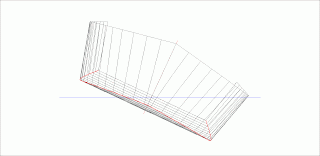Naval Architecture and small craft design as we know it today is a relatively new process in human terms. By that I mean the design of boats by the use of paper drawings and, more recently computer modelling. I do not know enough about the detail of the history to make any definitive statements without research, but broadly speaking I think that the last 300 years would just about cover the span of "paper" design.
 |
| Boatbuilding (and presumably design) in present day Vietnam. Photo courtesy Bill Bradley |
Once again in general terms, small craft design lagged behind when it came to plans drawn on paper as the first step in producing a boat. Well into the twentieth centuary, and in fact right up until today, small boats have been designed and built by eye and intuition, coming together and evolving on the builder's strongback.
I've got plenty of boat designs in my own portfolio, but I've only published a few. When I say designs, what I really mean is that I have a large number of lines drawings and finished computer models (even some carved half-models, of which the current computer models are a modern equivalent). Although the modelling of a hull, calculation of the hydrodynamics, and the drawing of the lines represents a large part of the creative side of boat design, the really time-consuming part is the detailed drafting of the building plans. Much modern design software deals with the detailed structural drafting semi-automatically, but I do my drawing manually, line-by-line in a simple 2D CAD program. Effectively, it is simply drawing in a conventional manner, but using an electronic drawing board - at least it makes erasure much cleaner!
 |
| This photo shows me making the lines drawing of Phoenix III. These days I do it electronically. |
For a number of years now I have felt uncomfortable about the number of plans being pumped out around the world for commercial gain. I know that people are always after something just a bit different, but in years gone by,
existing designs evolved to meet the requirements of the customer rather than the market being flooded with new designs just for the sake of having a new design. The result was that bad elements were designed out and good elements were improved upon, giving rise to boats which were better and better suited to their intended function. It is with that in mind that I have been holding back on publishing extra plans.
In the last couple of weeks, I have been approached by a customer who had bought a set of plans for my
Phoenix III design, asking whether the boat could be built using the glued-strip plank method.
 |
| The very first Phoenix III on launching day. Photo Rhonda Lillistone |
Now, I designed
Phoenix III from the very outset to have five wide planks of plywood planking making use of the excellent glued-lapstrake building method. My idea was to make use of the cross-grain strength of marine plywood, and to capitalise on the width of the available material. Also, I was aware that many people are intimidated by the thought of making a large number of planks, so I felt that five wide planks would provide a good compromise between a rounded lapstrake hullform and ease of building. The resulting boat has been very sucessful, and I'm quite proud of the overall design.
 |
| Phoenix III has several different rig options - this is the balance lug, which sets on exactly the same mast as the sprit rig. Photo Paul Hernes |
Because I designed
Phoenix III for five wide planks per side, I drew the bulkheads and molds with a number of flats to take the individual planks. This makes it much easier for an inexperienced builder to determine the lay of the planks and makes spiling (the determination of the plank shape on the flat) much simpler. The problem is that it would not allow the customer to build the boat using the glued-strip-plank method. I was tempted to tell him to use a spline to simply draw a curve through the points of the flats on all of the sections, but I wasn't convinced that the resulting shape would be fair.
 |
| A half-section through the hull, showing how the wide planks lay against flats on the bulkheads and molds. |
What I ended up doing was to import the existing hull shape into the
DELFTship Professional which I currently use for hull modelling, and then altered the entire hull from one with five flats per side, to one with a fully rounded, smooth hull surface.
 |
| Phoenix III perspective |
 |
| Phoenix III perspective |
 |
| Phoenix III lines plan |
I have since carried out a similar modification to my
Periwinkle design, which was drawn in the same way as
Phoenix III.
 |
| Periwinkle on launching day. Photo Paul Hernes |
One of the side benefits of this process has been that I have been able to make variations to the hull shapes where thought beneficial. In the case of
Phoenix III I left her exactly as designed with the exception of making the hull smoothly rounded. But for
Periwinkle, I increased the height of the
bow very slightly and filled out the sheer line forward in plan view a little. This was made possible because the smoothly rounded hull does not have to comply with the limitations of developable plank shapes, which is necessary with the five plank hullform.
So, here is an example of improving (hopefully) existing designs with small, incremental alterations carried out where experience indicates they may be beneficial.
Having said all of this, I encourage anybody who feels the urge to have a go at designing their own boat. Experience begins at the beginning!




























